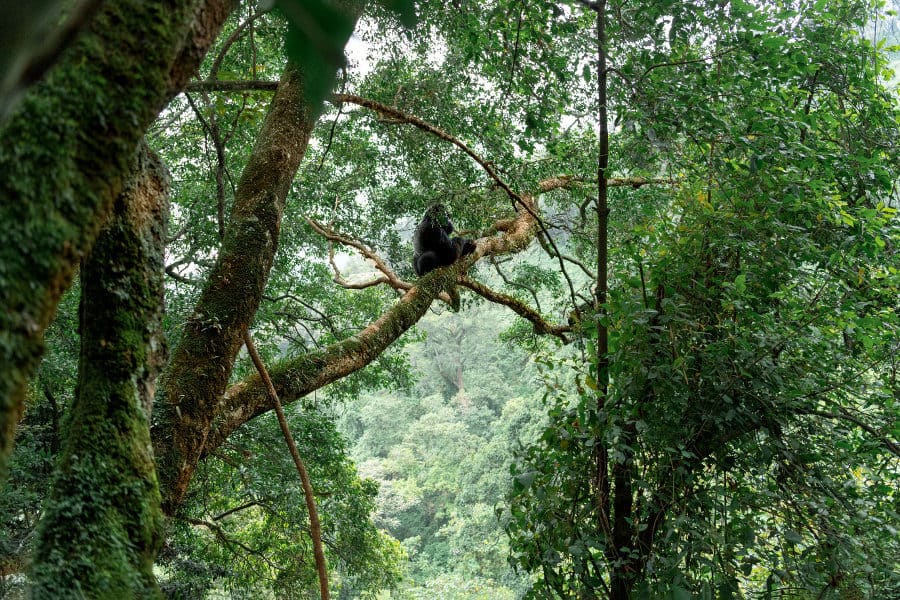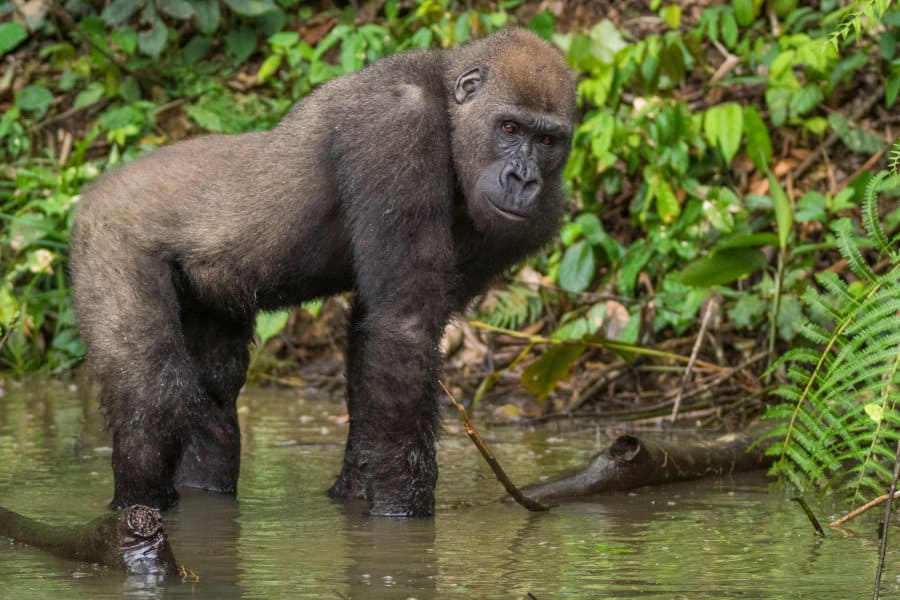The mountain gorilla, a critically endangered species marooned on volcanic islands in the clouds.
No other primate is as big. No other animal better reflects the conflict between people and nature. And perhaps no other animal is as beautiful as the mountain gorilla.
This article celebrates the mountain gorilla in all its glory, from the forests of Uganda to those of Rwanda next door!
Mountain Gorilla Facts

- Mountain gorillas have never been tamed or taken captive. You cannot see these animals in a zoo because they have never been in a zoo.
- Mountain gorillas are the world’s largest primates and are considerably larger than their lowland gorilla cousins.
- These epic apes only live in three different countries – Uganda, Rwanda and the Democratic Republic of Congo.
- Just over 1000 mountain gorillas remain and the species is endangered on the IUCN list.
- Good news – their population is on the increase!
- Silverback gorilla males reach 200 kg in weight and stand upright at 1.7 metres!
- Females are roughly half the size of males, weighing around 100 kg and only measuring about 1.4 metres.
- Mountain gorillas and humans share a common ancestor; the big furry apes split from their primate cousins around 9 million years ago.
- Mountain gorillas live around 40 years in the wild, although some have been known to live to almost 50.
Get to Know the Mountain Gorilla
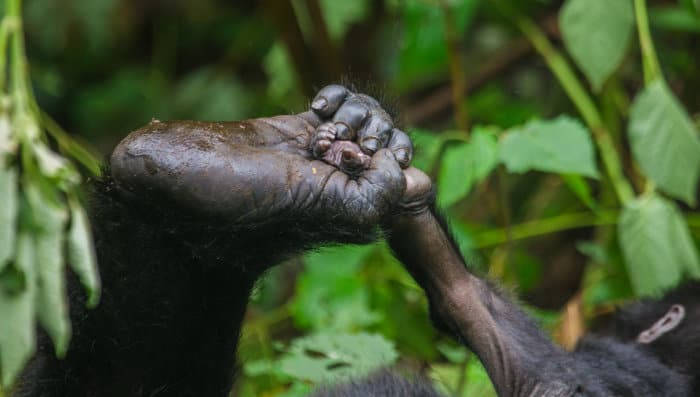
Through the trees you spot a glimpse. A ball of black fur moves on all fours through the forest. You creep closer. And closer. Bashful and beautiful the mountain gorilla returns your gaze. Time seems to stand still as you come eye to eye with the world’s largest primate.
That’s a quick insight into mountain gorilla trekking, one of the world’s most intimate wildlife experiences. It’s only possible in two places and this detailed gorilla trekking guide will talk you through all the differences between trekking in Rwanda and Uganda gorilla trekking.
Most people base their impressions of mountain gorillas on King Kong and other fictitious sources. No, gorillas are not taller than skyscrapers. And no, they are not brutish animals.
Mountain gorillas are actually very shy. They seek solitude in the forest and go out of their way to avoid encounters with other mammals.
Despite their reputation as being all brawn, these giants are highly intelligent and social animals. In fact, they are one of the planet’s most sophisticated species.
It’s such a shame that movies like King Kong portray them as monsters we should be frightened of. There’s nothing scary about mountain gorillas, as long as you show these animals the proper respect.
Know your mountain gorilla from all the other gorillas
Humans are not necessarily a good thing for the earth. There are four different species of gorilla and ALL these species are critically endangered.
Mountain gorillas are the largest of them all and are native to small forests in Rwanda and Uganda, as well as the Democratic Republic of Congo. Compared to the other species, mountain gorillas also have shorter arms and longer hair.
Their closest cousin is the eastern lowland gorilla. Around 3000 of these gorillas keep their species alive, mostly on mountain slopes in the Democratic Republic of Congo.
Less than 250 cross river gorillas remain and their population has declined 60% in the last 25 years. This species occupies dense forests around the border of Cameroon and Nigeria, in areas far from humans. Their size and behaviour is very similar to mountain gorillas.
If you have seen a gorilla in a zoo it will be a western lowland gorilla. This is the smallest of the gorilla species and occurs throughout western Africa, in forests and swamps from Angola to Gabon.
What is a group of gorillas called?
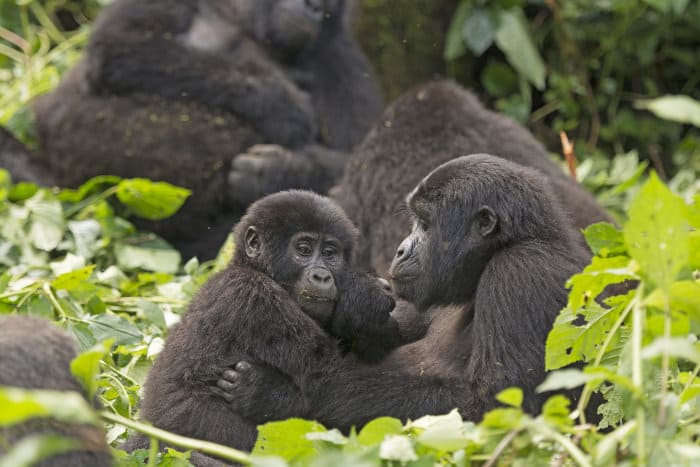
Gorillas group together in troops. Some people also say a band of gorillas. Whoop has also been used as a collective noun but that’s an archaic term.
Troops can be anywhere from 8-30 individuals. While they act as one and behave like families, they are not purely natal groups. Most mountain gorillas emigrate to a different troop to the one they were born into.
Sometimes they leave and immediately join a new troop. Or they wander on their own for a while before deciding on a new troop. Or there is a split in a troop with some traveling one way and the rest staying behind.
It’s relatively common for young males to band together. This behaviour is similar to many other African animals. Young males form bachelor groups and build their strength until they can compete for females.
Mountain gorilla troop behaviour
Every troop consists of a dominant silverback, a mature male that leads a patriarchal society. Silverbacks are easy to identify – they have a shining band of silver fur across their backs.
It’s the silverback that protects the troop against threats and mediates arguments within the troop. He will adopt offspring from mothers who have left and can even remove poachers’ snares from others.
Younger males don’t have the silver fur, so they are known as blackbacks. The silverback will tolerate their presence as long as they remain subservient. Any attempt to challenge for power or sneak off with a female will not be tolerated.
Most silverbacks will lead a troop for around five years. After that a stronger male will take over. In some cases the original leader is allowed to stay with the troop. One troop in Bwindi Impenetrable Forest has four silverback gorillas! However, only 40% of all troops contain more than one adult male.
Different females coexist in these cohesive troops. In general, there are very strong bonds between mountain gorilla males and females, but not between females. Youngsters typically stay with a troop until they are around ten years old.
Mountain gorilla habitat

All gorillas live in the trees. They prefer thickly forested habitats where there are lots of plants and shoots to feed on. Other than a few that cross the border into the Democratic Republic of Congo, mountain gorillas are restricted to two small and protected forests.
These are Bwindi Impenetrable Forest in Uganda and Rwanda’s Volcanoes National Park.
Gorillas are like humans in that their hands are not specially designed for climbing trees. Chimps and monkeys have adapted special thumbs and features so they can swing around at will. Not us, nor gorillas, even though they live in the trees.
These giant apes also like silence and solitude. They don’t want to be around rowdy neighbours and will shy away from conflict. Mountain gorillas really are nothing like the image portrayed in King Kong.
These animals are not territorial either. Although a silverback is highly protective of his troop, different troops will seek to avoid each other. They happily allow other troops to wander by and are not precious about where they live.
Bringing baby gorillas into the world
Go gorilla trekking and it is the baby gorillas that you will find the cutest. They swing in the trees, play with their aunts and uncles, and cuddle up to the silverback.
Infants are heavily reliant on their mothers and ride around on their mothers’ backs for most of their first three years. When born they weigh just 2 kg! That’s half the weight of a human baby, even though a male mountain gorilla will eventually become more than double the size of a human.
It takes over three years to wean baby gorillas off their mothers’ milk. For most of their early years they are helpless and can only cling on to others for support. Then things get really interesting.
The similarities between mountain gorilla infants and human toddlers are fascinating. From the ages of three to six they spend their days playing. They can be seen climbing trees, chasing friends and swinging from branches. Toddlers and gorilla infants will seek their protective parents but also become annoyed and frustrated when they don’t get their own way.
Females are sexually mature at around ten years old. Males are mature at a similar age but will have to wait a few years before getting a chance to mate.
Gestation is 38 weeks. That’s only two weeks shorter than human gestation. It’s just another close similarity from a species that shares 96% of our DNA.
What do mountain gorillas eat?

Mountain gorillas do not eat meat. So how do they grow so fast in such a short period of time? A baby gorilla weighs 2 kg but within 20 years will become 200 kg of pure muscle.
These animals have barely an ounce of fat. Their strength to weight ratio is one of the highest in the animal kingdom and it’s mostly down to a sustainable vegetarian diet.
Mountain gorillas spend most of the daylight hours feeding on leaves, plants, buds, shoots and roots. Sometimes they chomp on ripened fruit or gnaw on tree bark.
However, they are not absolute herbivores. Mountain gorillas are omnivorous and also eat small invertebrates, such as termites, worms, ants and larvae.
Their secret is quantity. A silverback mountain gorilla can eat 20 kg of food every single day! Just imagine how fit you can be if you consume 20 kg of raw vegetables every day!
What sound does a gorilla make?
Gorillas are capable of a huge range of sounds. Dian Fossey wrote about 17 different vocalisations in her book Gorillas in the Mist.
- Belching is a non-threatening sound indicating the gorilla is happy in its surroundings.
- Singing is another sound of contentment and is more high pitched than belching.
- Mountain gorillas beat their chests with open hands (not clenched fists as King Kong depicts) – this is a show of strength, not a signal to fight.
- Screams and roars are frightening shows of power, a deafening waaaaaaah sound that scares others away.
- Uh uh uh – this classic mountain gorilla sound means back off.
- Laughter is common within troops and it sounds very much like human laughter.
You can discover all the different sounds a gorilla makes here.
From Grasslands to Poachers – The Complete Mountain Gorilla Conservation Story

To fully understand gorilla conservation we need to look beyond what is happening now, or even what has happened over the last 50 years. We need to start way back in time, when Africa was covered in trees.
Volcanic forests in the clouds
The story of critically endangered mountain gorillas goes all the way back to a time when Africa was covered in forest.
Back then there was no Serengeti National Park. From the Congo to the Indian Ocean, the middle of Africa was carpeted in trees. Gorillas thrived and lived all over the area.
This was a time before humans and poachers existed. Primates thrived and there may have been over a million gorillas!
Over millions of years this forest was replaced by African savanna. Researchers argue about why this happened – essentially this was another piece of the earth’s natural evolution, just like the continents drifting apart.
As the savannah expanded the gorillas had to retreat. They traveled west to what is now the Congo. It was around this time that the gorilla species split into two, approximately 2 million years ago.
Western gorillas crossed the Congo. Lowland gorillas stayed around the Congo. Mountain gorillas ascended the mountains of what is now Rwanda and Uganda.
As the savanna took over the mountain gorillas became marooned in high-altitude forest. They couldn’t even descend and cross from Uganda to Rwanda or vice versa because the savannah took over.
Bwindi Impenetrable Forest and Volcanoes are relatively small national parks. They are dwarfed by other East African parks. There is not much space, certainly not for an animal that wants to eat 20 kg of food every day. And mountain gorillas have to share these parks with forest elephants!
Mountain gorillas are restricted to very small habitats that can only support a relatively small gorilla population. They have always been rare.
Enter the humans (and it was all okay)
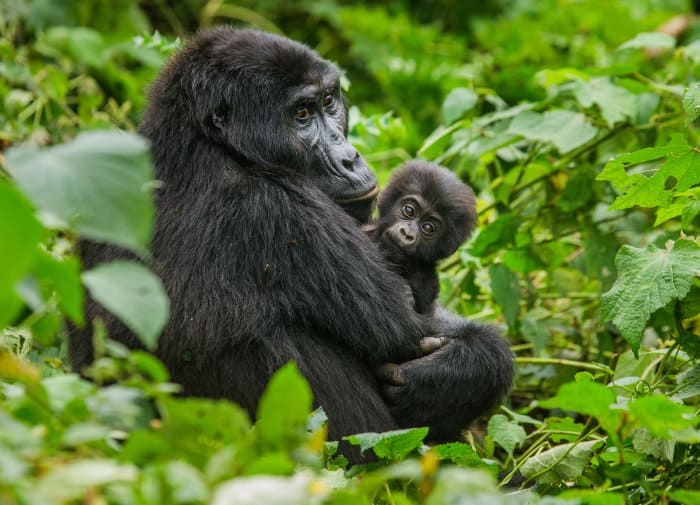
Then came the humans. At first the relationship between people and mountain gorillas was entirely peaceful.
These mountain forests were the realm of pygmy tribes, short-statured people who live in harmony with their own forest home. These indigenous people are known as Echuya Batwa in Uganda and Twa in Rwanda. Living in simple huts made from sticks and grass, they are semi-nomadic and survive solely from what the forest provides.
The pygmy people protected the forest and its inhabitants. They are not poachers, although they do set snares to kill forest antelope. Like the San people of Southern Africa, they only take what they need and don’t conduct any senseless killing.
As the populations of Rwanda and Uganda grew, more and more people came into contact with the forest. The pygmy traded with other tribes but still nobody interfered with mountain gorillas. After all, why would anyone want to interfere with such large and impressive animals?
Enter the other humans (and the problems started)
Did you know that Rwanda was assigned as a German territory during the 1884 Berlin Conference, even though no European had ever set foot in the country?
The first European to reach Rwanda was Gustav Adolf von Götzen. He arrived in 1894! That’s ten years after Germany claimed the country as their own! European explorers and naturalists didn’t know about Rwanda or gorillas.
Due to their secretive nature and inaccessible home, mountain gorillas remained off the radar of taxonomists and animal researchers. Although gorillas were known since 1847, it was only in the 1950s and 1960s that Europeans discovered wild mountain gorillas.
Imagine the interest back then. The biggest of all apes! Bigger than King Kong! People will pay to see such a beast!
And so it began. European zoos promised big money to anyone who could bring them a mountain gorilla. Adult gorillas would be too dangerous to transport and too difficult to tame, so they requested baby gorillas.
Poachers descended on what is now Bwindi and Volcanoes national parks. They killed entire troops in order to steal baby gorillas. No baby mountain gorilla ever reached Europe and none have ever been taken into captivity.
Some of the world’s pre-eminent zoos were complicit in this, including Frankfurt Zoo. You won’t find this information online, but it’s something Dian Fossey did a lot to challenge.
Conservation success and hope for the future

In 1978 there were less than 400 mountain gorillas. For most of the 1980s this population remained stable. Zoos no longer requested live gorilla babies but there were new threats, such as poaching for fur and meat.
Only in the late 1990s and 2000s did we see the success of the protection and conservation programs Dian Fossey initiated.
Mountain gorilla conservation is paid for by gorilla trekking. Trekkers pay for permits which provide much-needed funds to keep the wilderness and habitat wild. Villagers are employed as guides and porters so they aren’t tempted by poaching money.
Now the mountain gorilla population exceeds 1000 for the first time in 70 years. So things are looking up and you can still come face to face with the largest of the apes.
